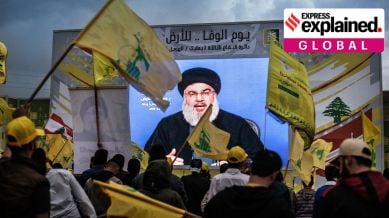The story of Hassan Nasrallah, leader of Hezbollah for three decades
Israel considered Nasrallah a terrorist, and Hezbollah has been designated a terrorist organisation by several countries.

Hassan Nasrallah, whom Israel killed in an air strike last week, led Hezbollah, the Iran-backed armed group and political party that controls much of southern Lebanon, for more than 32 years. Israel considered Nasrallah a terrorist, and Hezbollah has been designated a terrorist organisation by several countries.
Musawi, Khomeini, Hezbollah
Nasrallah, the eldest of nine children, was born in 1960 and grew up in Beirut’s poor eastern Bourj Hammoud neighbourhood, where many Christian Armenians, Druse, Palestinians, and Shias lived. His father Abdul Karim, a seller of fruits and vegetables, came from Bazouriyeh village in southern Lebanon.
In 1975, as civil war broke out in Lebanon, Nasrallah, then 15, joined Amal, and started to organise members in Bazouriyeh. The following year, he moved to Najaf in Iraq to study in its famous religious seminaries. (Hezbollah: A Short History (2007), Augustus Richard Norton)
In Najaf, Nasrallah met the two people who would arguably have the most influence on his life: the Lebanese cleric Abbas al-Musawi, a co-founder of Hezbollah, who became his mentor and friend, and Ayatollah Ruhollah Khomeini, who would lead Iran’s Islamic Revolution in 1979.
Following a crackdown on Shia Islamists by Iraq’s Ba’athists, Nasrallah and Musawi returned to Lebanon in 1978. Nasrallah left Amal in 1982, convinced that the movement was “no longer up to the task” of resisting invading Israeli forces.
He joined the paramilitary Islamic Amal, which was co-founded by Musawi and backed by Iran’s Revolutionary Guards. Islamic Amal was the most prominent and effective of the Shia militias in Lebanon, and carried out suicide bombings at the US Embassy in Beirut and the barracks of American and French peacekeepers, killing at least 360 people, including 241 American service members.
In the early 1980s, the Shia militias formed Hezbollah, the “Party of God”. Nasrallah began as a fighter, and quickly rose to become the group’s director first in the city of Baalbek, then the whole Bekaa region, and then Beirut. In 1985, Hezbollah announced its aims: fighting Israel and the West in Lebanon.
In 1992, after Israel killed Musawi, Nasrallah became chief of Hezbollah at the age of 32. His retaliation included Hezbollah bomb attacks at Israel’s embassies in Turkey and Argentina; 29 people were killed in the latter attack.
Leader of wars against Israel
The killing of Nasrallah’s 18-year-old son Hadi by Israeli commandos in 1997 raised his stock among Hezbollah’s members and supporters. “The…stoic acceptance of his son’s death is often cited by party members as one of the reasons he is so highly esteemed,” wrote Norton. The day after Hadi’s killing, Nasrallah said: “We, Hizbollah’s leadership, do not jealously guard our children.”
Nasrallah’s success in the low-intensity war against Israel that led to the Jewish state ending its 18-year occupation of southern Lebanon in 2000, cemented his reputation as a wartime leader.
At the same time, under Nasrallah, Hezbollah worked to develop a large welfare network in Lebanon, including health centres and schools. Hezbollah worked to become a political force (the pro-Hezbollah bloc has 62 of the 128 seats in Lebanon’s parliament today), even as it built up a formidable military arsenal with the help and backing of Iran. The group is currently believed to have hundreds of Fateh 110 ballistic missiles with a range of 260 km, according to a report in The Economist.
In 2006, Nasrallah led Hezbollah in another war against Israel, triggered by the kidnapping of two Israeli soldiers. The 34-day conflict resulted in large-scale destruction and loss of life.
Thereafter, Nasrallah began to project himself as the champion of all Muslims in the war against Israel. “Nasrallah is vainglorious… He sees himself as a unique, visionary figure, a revolutionary hero like Che Guevara,” researcher Hussein Ibish said in a 2006 interview with the Council on Foreign Relations.
As Israel focused closely on him, Nasrallah began to live largely underground to evade possible assassination attempts. His speeches were broadcast from unknown locations and delivered via secure links to his followers.
A massive loss for Hezbollah
Nasrallah helped expand Hezbollah’s influence well beyond the borders of Lebanon. It supported the government of President Bashar al-Assad in Syria when it was threatened by a popular uprising that started in 2011. It also trained fighters from Hamas, as well as other members of Iran’s so-called Axis of Resistance, including Iraq’s Shia militias and Yemen’s Houthis.
It will be a daunting task for Hezbollah and its patrons in Tehran to find a replacement for Nasrallah. The group has lost several key leaders in Israeli strikes in recent weeks, and there does not appear to be anyone surviving who is close to Nasrallah’s stature, experience or influence.
“Nasrallah will be difficult to replace… Any successor will lack his political stature in Lebanon and personal relationship with Iran’s supreme leader,” Norman Roule, a veteran of the CIA who worked at the Office of the Director of National Intelligence, told Radio Farda, the Iranian branch of the US government-funded Radio Free Europe/Radio Liberty.